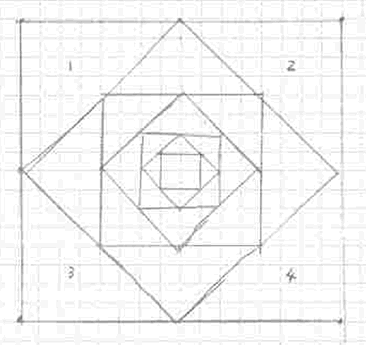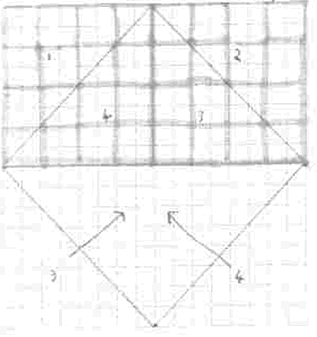Copyright © University of Cambridge. All rights reserved.
'Inside Seven Squares' printed from https://nrich.maths.org/
Show menu
You have found several different ways of answering this problem which is great. Many of you, including Fiona at Tattingstone School and Douglas at Burgoyne Middle School, decided to draw the squares. However, your approaches weren't necessarily the same.
This is what Fiona says:
The first thing I did was to get some squared paper to draw the figure on. I found out I couldn't start the middle square as one square because I couldn't draw the other squares accurately so I did the middle square as a four and that gave me points for the rest of the figure. |
To find the total area of the numbered triangles:
I noticed that $1$ and $4$ were two halves of a square and
also $2$ and $3$ are two halves of a square.
|
 |
Now I just have to count every square in this top rectangle as one unit: My answer is $32$ square units. |
Courtney, Charlotte and Tyler from Gateway Primary also used this approach.
Here is what Douglas did:
1) I drew the squares starting with the inside square that
measured $1$ cm by $1$ cm.
2) I measured the sides and calculated the area of each of the
outside triangles: Height $4$ cm width $4$ cm Area of $1$ triangle
= $8$ cm
Sally also sent us her solution. She spotted
some interesting patterns: good work!
When I drew the squares, I knew the first one had side length
$1$, then the third one had side length $2$, the fifth had side
length $4$, and the seventh had side length $8$ (they kept
doubling). I drew the picture on squared paper, and when I counted
the squares, each square (all of them, not just the odd ones) had
area twice as big as the one before. So the first one had area $1$,
then the next one had area $2$, then $4$, then $8$, then $16$, then
$32$, then $64$. The area of the triangles is the area of the
biggest one take away the area of the next one down, so that's
$64-32=32$.
Gemma and Nathalie from City of London Freemen's School, Roger, Mark and Sam from Spalding Grammar School and George from Strand on the Green Juniors also noticed this pattern and so they didn't need to do any drawing to find the solution. Nathalie wrote:
As each square is half of the square surrounding it the total
area of the outside square is $64$. You then have to take away the
square directly inside it to find the area of just the outside
triangles. As the square directly inside it is simply half the
outside square then we are left with $32$ as the area for the
outside triangle.
Well done too to Callum from Arthur Mellows Village College and children from Truscott Street Public School.